How to Ripen and Store Avocados
We tested popular avocado-ripening methods to see which ways work and which ways don't.
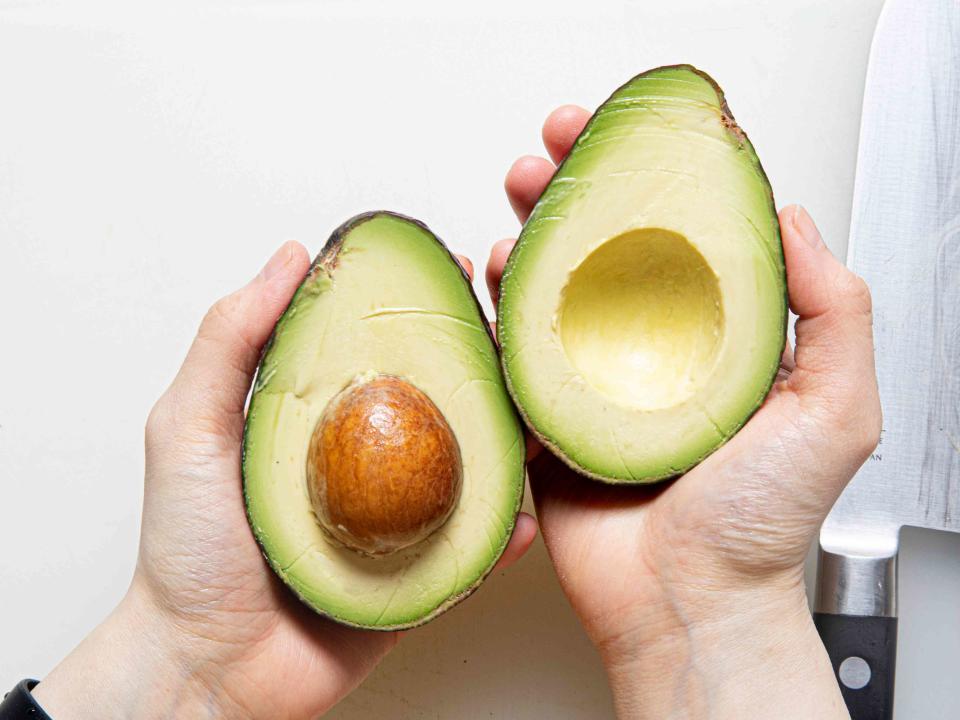
Serious Eats / Amanda Suarez
Avocados occupy an interesting place among commercially popular fruits. Unlike most other fruit, avocados do not ripen on the tree—they only begin ripening off the tree after reaching full maturity. But then the race to ripeness is off and running, and, in the case of avocados, that race is relatively quick, with limited opportunities for long-term storage.
These two facts put the concerns of commercial avocado growers, shippers, and vendors exactly opposite of those of the home cook. Those in the avocado industry want to find as many ways as possible to delay ripening of the picked fruit for as long as possible, buying them as much time as possible to get the avocados from the filed to your kitchen counter in good condition. Through lots of study, they've become pretty good at that—by lowering temperatures, reducing environmental oxygen and boosting carbon dioxide, shrink-wrapping or waxing the fruit, and other techniques, the avocado industry can manage to keep the fruit in its mature-but-unripe state all the way to the point of sale, despite significant shipping distances and other challenges.
The home cook, on the other hand, usually wants to know how the heck to speed up ripening so they can eat the darned thing. This can present a timing challenge when shopping for and eating avocados because, to put it bluntly, perfectly ripe avocados are a pain in the ass to find. The window of time in which they are absolutely perfect—soft and tender with no brown spots or streaks—is notoriously short. It can make planning an avocado-based party a harrowing experience. Will my avocados ripen in time for game day? What if they turn brown?
Fortunately, there are a few ways to moderate the rate at which they ripen, and then there are some ways other articles on this topic recommend, but we don't. Read on for more.
How to Choose a Quality Avocado When Shopping
We've all seen those avocados that seem perfect on the outside, but once you cut into them, a series of deep brown stripes and striations appear. What's up with that?
Unfortunately, it's not something that can be predicted or prevented. It's caused by uneven enzymatic action inside the avocado as it's developing and is exacerbated by extreme weather conditions and other seasonal, environmental, and agricultural factors.
For Hass avocados, you can expect the likelihood of this phenomenon to increase starting in December and maxing out around February. (Ack, Super Bowl season!)
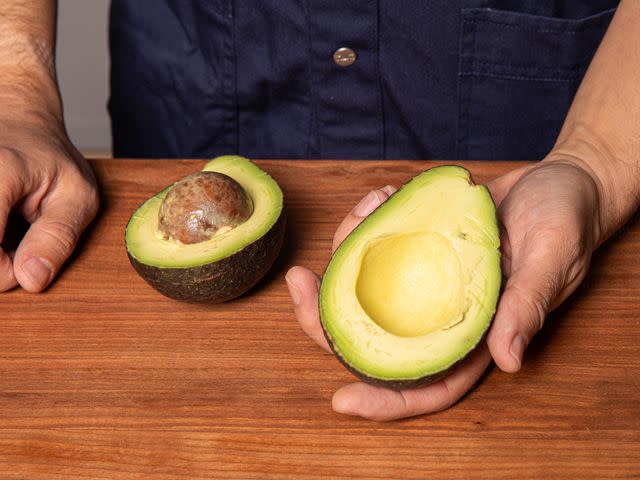
Serious Eats / Amanda Suarez
Another common flaw in some avocados are woody strings that stretch through the flesh. These strings are part of the plant's vascular strands, responsible for transporting nutrients into the fruit. They're actually always there, but they only become noticeably woody and stringy later in the season as the avocado becomes more mature.
Unfortunately, just as with the brown spots, there's no way to predict which avocados will have these strands until you've cut into it, aside from knowing that the likelihood of encountering them goes up later in the growing season, with fruit harvested in the late summer and early fall (though this will vary depending on the avocado variety and growing region).
How to Know If an Avocado Is Ripe
While the color of the avocado's skin can change as ripening progresses, that is not a reliable way to determine perfect ripeness, since avocado skin color can vary from variety to variety and fruit to fruit. Better is to gauge ripeness by touch: Using your fingers, very gently press on the avocado near the stem end (that's where the avocado was once attached to the tree). You want to feel a slight tenderness and give. If the avocado is very firm, it's not ready; if it feels soft and mushy, it's gone too far.
The Best Ways to Ripen Avocados: Tested
Ripening in avocados and many other fruits is regulated by a gas called ethylene. It's produced naturally by the fruit itself and is intended to make sure that all the fruit in one area ripens at the same time. The higher the concentration of ethylene, the faster your fruit ripens. That's why you'll see instructions to leave underripe avocados or bananas in paper bags—it concentrates ethylene and causes fast ripening.
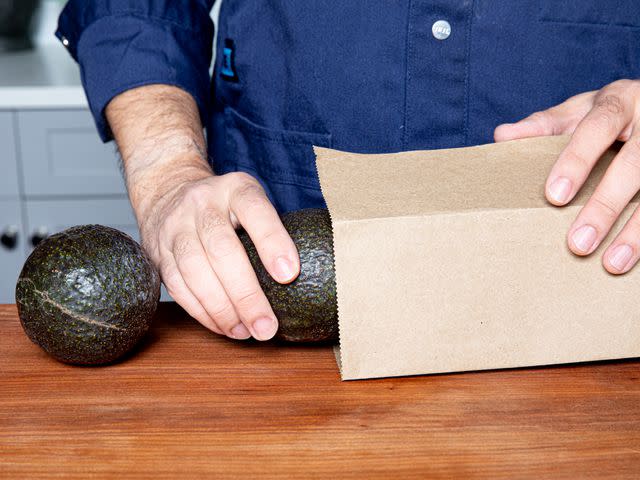
Serious Eats / Amanda Suarez
Left on its own, it generally takes an underripe avocado somewhere in the range of three-to-five days when stored in a paper bag at room temperature. If you need your avocados sooner, you will need to turn to other fruit.
How to Ripen Avocados Quickly
In side-by-side tests tests, avocados from the supermarket showing no softness at all take between three-to-five days to ripen in a brown paper bag. Throw a banana in there (an ethylene powerhouse), and you can bring that range down to two-to-three days. It's not instant, but it does give you a wider range of control over having a ripe avocado when you need it.
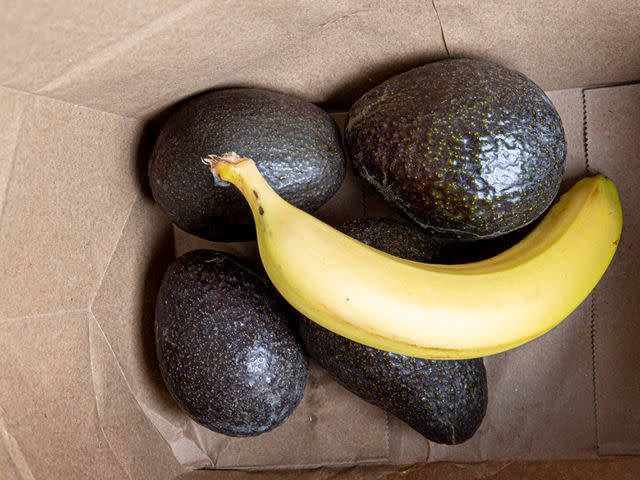
Serious Eats / Amanda Suarez
You could, for instance, buy several avocados, leaving some out in the open kitchen air, some in a brown paper bag, and yet a few more in a second brown paper bag with a banana added. By doing so, you'd stagger their ripeness-reaching days, with the banana-ripened avocados ready in a couple days, the paper bag ones a day or two after that, and the open-air ones ready right on the heels of those, assuming they all started at the same stage of un-ripeness.
Can You Ripen an Avocado in the Microwave?
This is one of those popular internet and social media tips that sound so good, we all just want to believe it's true. You can rapidly ripen an avocado in the microwave?! Thank you, TikTok!
But we're sorry to say, having tried it ourselves, it's a terrible method.
The truth is, using the microwave (or a low oven for that matter) does not ripen an avocado at all, it cooks it. Indeed, there are similarities between cooking and ripening: In both cases the fruit's flesh softens as cell walls weaken, leading to a more tender texture. On top of that, new flavors and aromas develop. But the way the texture changes, and the nature of the flavor and aroma changes are not comparable between ripening and (even very, very gentle) cooking. While a properly ripened avocado grows buttery and creamy as time passes, a microwaved one becomes slick and sweaty, and soft like a lit candle—overly mushy in the hotter spots and still too firm in others.
The flavor of a microwaved avocado, though, is by far its greatest failing. We would describe it as re-warmed, undercooked chicken, a bizarre combination that somehow manages to smell simultaneously of the crudeness of raw poultry and stink of reheated poultry. A microwaved avocado might be easier to chew, but it's not easier to swallow.
How to Store Ripe Avocados for Later
Once ripened, an avocado will start to produce brown spots and streaks within about two days if left at room temperature. However, refrigerating a ripened avocado can increase that window up to around five days, though avocados are susceptible to chilling damage, so the will begin to show signs of browning if left too long.
The best way to guarantee perfect avocados for a Sunday night game? Buy them the Monday before, ripen them at room temperature in a brown paper bag and refrigerate them as soon as they soften.
How to Prevent Avocados From Browning
What about leftover avocado? Any way to keep it from browning? Oxygen is the enemy of avocados—it's what causes them to turn that unsightly brown. Plastic wrap works alright on cut avocado halves, but even plastic wrap is oxygen-permeable. In our tests, avocados didn't last more than about eight hours wrapped in plastic before visible browning occurred.
The old rub-with-oil-and-place-face-down-on-an-oiled-plate works fine if you've got a perfect half of an avocado with a smooth face, but it doesn't help if you've got, say, 3/4 or 1/4 of an avocado.
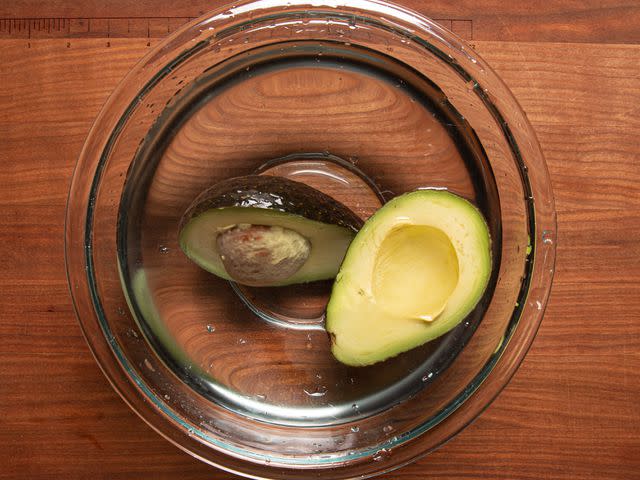
Serious Eats / Amanda Suarez
The better short-term solution in that situation? Just submerge the sucker in water. Simply put any unused avocado pieces in a container filled with water in the fridge to keep oxidation at bay, but do note you can't hold them there for long. After several hours, a ripe avocado will begin to grow mushy where water has managed to penetrate it.
As for mashed avocado like guacamole, we think the best solution, aside from preparing it right before serving, is to press a double layer of plastic wrap directly against the surface of the avocado mixture. It's not a perfect solution—the avocado will still brown eventually—but you can mix in a minimal amount of browning such that diners won't know, buying yourself at least a few hours before it becomes a problem.
Portions of this article were originally written by Kenji Lopez-Alt as part of the headnote to his guacamole recipe. Those sections were removed from that headnote and added to this article, with additional reporting, testing, and text by Daniel Gritzer.

